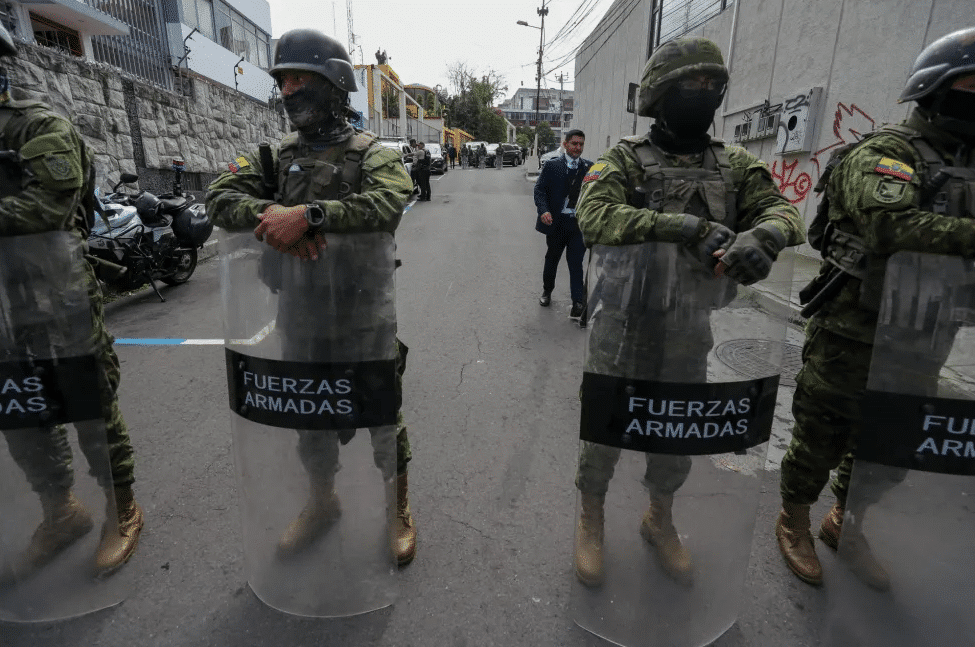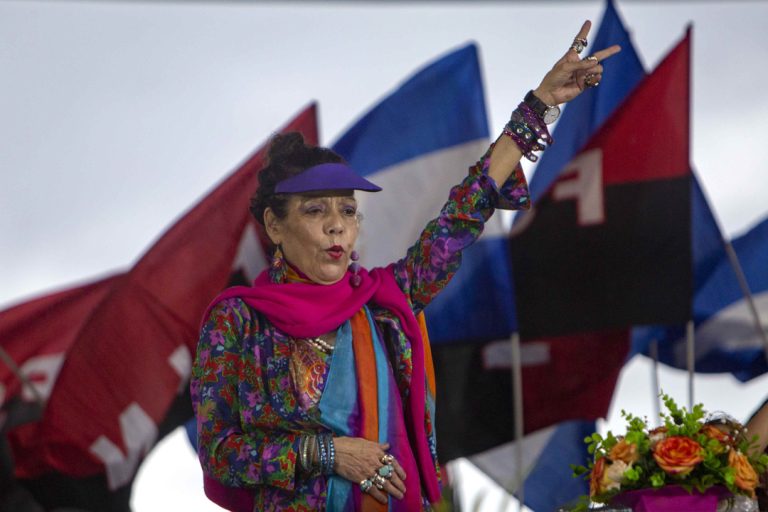20 de noviembre 2018

The Return of the Military

PUBLICIDAD 1M
PUBLICIDAD 4D
PUBLICIDAD 5D
The logbook of e-mails sent by Rosario Murillo between April 19th to 25th

The orders that Rosario Murillo sent to her political secretaries in public institutions of Managua during the first days of the April rebellion.
The orders that Rosario Murillo, acting as the FSLN’s national chief, sent to her political secretaries in public institutions of Managua during the first days of the April rebellion, reveal the strategy with which the government tried to deal with the social discontent that exploded on April 18th.
These actions included an emergency meeting in the Japanese Park auditorium, a plan to occupy 61 “emblematic points” of Managua, chains of prayer to advocate for peace, the mobilization of public employees to take to the streets and an intense propaganda campaign on official TV channels.
Faced with the failure of this political strategy, then came the brutal police and paramilitary repression that claimed the lives of more than 325 people.
Confidencial has in its possession eight emails and directives that Rosario Murillo sent between April 19-25, addressed to the political secretaries of the FSLN in public institutions and the districts of Managua, endorsed by the Managua Departmental Committee of the Sandinista Front (FSLN). The list includes more than 200 individual mails from the Sandinista Leadership Council (CLS in Spanish), organized in all public institutions, as well as closed lists of territorial political secretaries, and members of the cabinet and diplomatic service.
Besides from the directives of the “compañera” (comrade) as Murillo is called, in the emails are “memos” urging political secretaries of higher rank to “coordinate actions” with the district political secretaries to implement the strategy devised by the Vice President.
The emails from April 19 to 23 were written in an urgent tone, in Courrier New font, size 17.5, and with the orders highlighted in red. The emails allow us to know first-hand how Murillo handled the crisis from day one, when she had not yet called the peaceful protesters “blood thirsty vampires.”
On April 19th, the Managua Departmental Committee convened an urgent meeting at 12:30 p.m. at the Japanese Park, in Managua. The protests in the streets began to take on a national dimension in Sandinista strongholds such as Leon and Esteli.
“We are calling an Emergency Meeting of the Institutional CLS, to be held TODAY, Thursday April 19th, at 12:30 noon, at the Japanese Park Auditorium, which must be attended by 5 “compañeros” from each institution,” invited the Sandinista Leadership Council. It called for two political secretaries, two Sandinista Youth coordinators and a general secretary of the unions to attend the meeting.
On April 20, at 4:04 in the afternoon, Murillo urged, through the Managua Departmental Committee, that the “emblematic points of our city” be “immediately” occupied.
“With instructions from our National Leadership, we must ensure the immediate presence of all our institutional militancy in 61 emblematic points of our city, as well as all the required logistics, in coordination with our District’s Political Secretaries, we will occupy these points for an indefinite period,” ordered the email.
The 61 sites described were divided by districts, and many of them are those that the government managed to take only three months later with the deployment of the armed paramilitary groups. Murillo assigned an “emblematic point” to each of the government ministries. For example, the Centroamerica roundabout was assigned to the Nicaraguan Municipal Development Institute (INIFOM) on April 20.
After the meeting in the Japanese Park and the directive to take Managua, Murillo sent another email on April 21 at 8:13 pm ordering the institutional Sandinista Leadership Council to “coordinate immediate actions with the District Political Secretaries.” The violence was blossoming and the repression, by that date, had caused six dead, including a policeman, and dozens of wounded, mostly students.
In her email Murillo does not allude to the existence of any “coup d’état,” although she claims that “promoters of hatred and the empire seek to destroy peace in the life of our country.” That message corresponds to the directive that the Vice President sent on April 22 to the political secretaries of her cabinet, and the “compañeros” (her sons) Daniel Edmundo Ortega M., Juan Carlos Ortega M. Maurice Ortega M., owners of the television channels 4, 8 and 13. Murillo even included the hashtags to use in social networks.
Among the addressees of the directive, she added officials of the government’s cabinet, political secretaries in different institutions, ministers, the diplomatic corps, the children of the presidential couple, and official media outlets.
“We have communicated with each of you, to specify how we will continue to mobilize in all the established points, defending life. Our work is to defend life. Our work is to defend peace. They are generating crimes and violence throughout the country,” wrote Murillo. “Let us denounce every attempt, every threat, every assault on institutions, work centers, health centers, study centers. Let us report them immediately through our media. This is the defense of life. With each media report and in the social networks, and the brave actions in each place, let us defend life,” she added.
On Monday April 23, Murillo sent a second directive, this time extended to Nicaraguan ambassadors around the world. According to the Vice President, that day was Saint George’s Day, so “we woke up fighting the evils belonging to our own human condition, and becoming strong in the fight against the dragon, with the seal and arms of Saint George; with the sword of Saint Michael the Archangel and the cuirass of Saint Patrick, in the incessant calling of our churches to peace, dialogue, work and reconciliation.”
In the midst of this political-religious rhetoric, Murillo ordered for there to be convened in “every municipality, region, community, department of our country, vigils and days of prayer and peace, as Nicaraguan brothers and sisters, as Nicaraguan families, that are sure of what Nicaragua wants and needs: work, peace, tranquility and security.”
Murillo’s strategy turned to the chains of prayer in public institutions. On April 24th she ordered that they should “ensure chains of prayer, from 4:00 to 5:00 p.m., outside of each institution, invoking God for peace, dialogue, non-violence and life in Nicaragua.”
Although it did not transcend to the media, Murillo called for days of “Peace and Good-will Missions.” On the same April 24th, and in the same email in which she ordered chains of prayers, the Vice President attached a directive in which she asked for “the unity of Sandinismo.”
In those days, the Sandinista strongholds had rebelled against the Ortega-Murillo regime. The civic rebellion was unstoppable. Monimbo, the mythical indigenous and insurrectional neighborhood that praised the presidential couple every year during the “El Repliegue” (the retreat), had risen up and was confronting the police. Early on Sunday morning, April 22, ex-guerrilla and math teacher, Alvaro Gomez, woke up to a devastating news: the officers had killed his son with a bullet in the chest during the protests in Monimbo.
“In all the Sandinista Leadership Councils of municipalities and departments of the country we call to strengthen the unity of Sandinismo, incorporating all those comrades that request to work for non-violence, dialogue and peace,” urged Murillo.
On April 25th, the Vice President sent another directive thanking the bishops for accepting the role of mediators in the national dialogue. In the same communication, she requested that the Sandinista Leadership Councils in municipalities, departments, institutions, social movements, youths, embassies, consulates, ministries and state institutions hold from four o’clock in the afternoon vigils and chains of prayers. “With Daniel, with the Front, with the People as President,” added the official spokesperson of the dictatorship.
The strategy failed and then came the brutal repression with the police and paramilitary rifles.
Archivado como:
PUBLICIDAD 3M
Periodista. Destaca en cobertura a violaciones de derechos humanos: desplazamiento forzado, tráfico ilegal en territorios indígenas, medio ambiente, conflictos mineros y ejecuciones extrajudiciales. Premio Iberoamericano Rey de España 2018.
PUBLICIDAD 3D